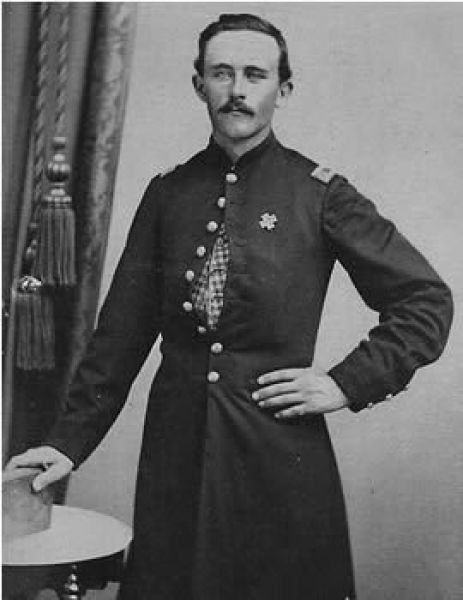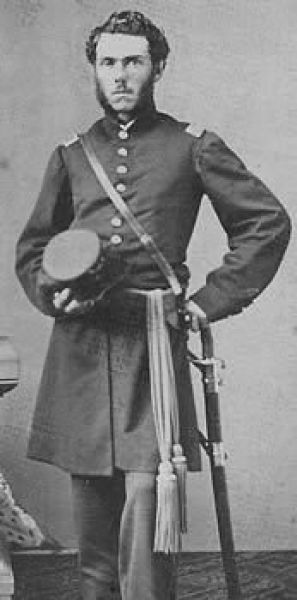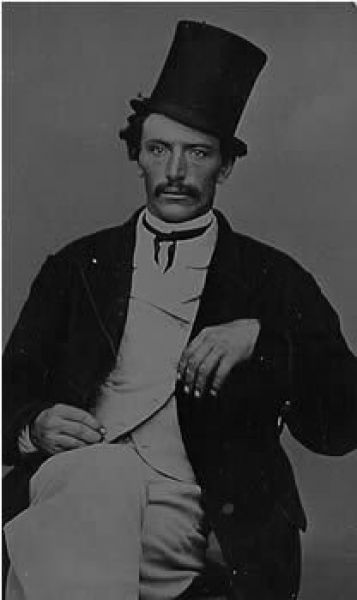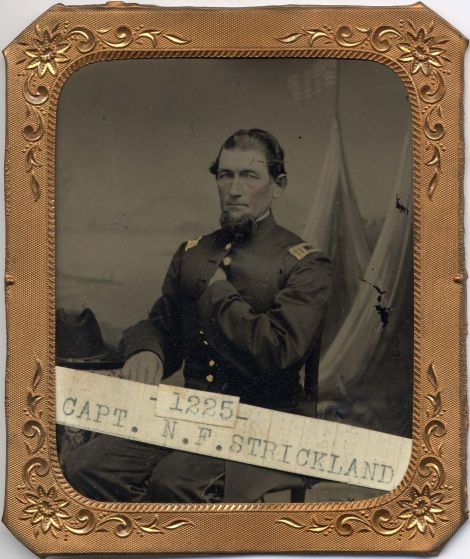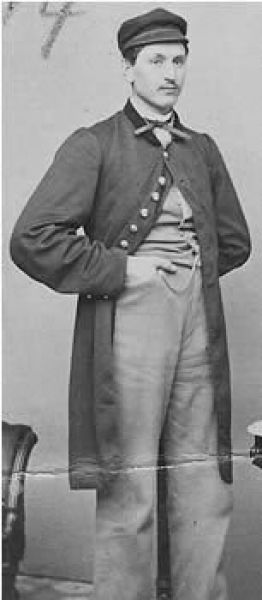9th Heavy Artillery Regiment
Nickname: Second Auburn Regiment; Cayuga And Wayne County Regiment
Mustered in as 138th regiment of infantry: September 8-9, 1862 .
Designated 9th regiment of artillery (heavy): December 19, 1862.
Mustered out: July 6, 1865.
The following is taken from New York in the War of the Rebellion, 3rd ed. Frederick Phisterer. Albany: J. B. Lyon Company, 1912.
The organization of this regiment was determined August 8, 1862, and Col. Joseph Welling received, August 12, 1862, authority to recruit the regiment in the, then, 25th Senatorial district of the State. September 29, 1862, this regiment was designated the 138th Regiment of Infantry. It was organized at Auburn, and there mustered in the service of the United States for three years, September 8 and 9, 1862. It was converted into an artillery regiment December 9, 1862, and designated, December 19th, the 9th Regiment of Artillery. February 5, 1863, the 22d N. Y. Volunteer Battery was, by the War Department, transferred to the regiment as Company M. Company L was organized at Albany and there mustered in the United States service for three years between November 4 and December 9, 1863.
The companies were recruited principally: A at Red Creek, Huron, Wolcott and South Butler; B at Williamson, Ontario and Walworth; C at Conquest, Cato and Victory; D at Lyons, Sodus, Huron, Rose and Galen; E at Venice, Scipio, Auburn, Moravia, Miles, Summerhill, Fleming and Montezuma; F at Geneva, Auburn, Owasco, Sennett, Niles, Lansing, Mentz and Aurelius; G at Wolcott, Savannah, Butler, Sterling, Huron and Rose; H at Galen, Butler, Savannah, Rose and Victory; I at Auburn, Owasco and Sennett; K at Clyde, Ira, Lyons, Wolcott, Galen, Williamson and Ontario; L in Albany county; and M at Batavia, Bergen, Bethany, Alexander, Darien and Oakfield.
The regiment (ten companies) left the State September 12, 1862, and served as infantry and heavy artillery in the defenses of Washington, D. C., north of the Potomac, from September, 1862; in the 2d, and later 3d, Brigade, Haskins' Division, 22d Corps, from February, 1863; the 1st and 3d Battalions in the 2d Brigade, 3d Division; the 2d Battalion in the Artillery Brigade, 6th Corps, Army of the Potomac, from May 25 and 31, 1864, respectively; the 2d Battalion in 1st Brigade, Hardin's Division, 22d Corps, at Washington, D. C., from July 10, 1864; in Colonel Keim's Provisional Brigade, from September 23, 1864; all in the 2d Brigade, 3d Division, 6th Corps, Army of the Potomac, from October 3, 1864; with the Army of the Shenandoah from October, 1864, and with the Army of the Potomac, from December, 1864.
It was honorably discharged and mustered out, under Col. James W. Snyder, July 6, 1865, at Washington, D. C., the men not entitled to be discharged then having been formed into four companies and transferred, June 27, 1865, to the 2d N. Y. Volunteer Artillery as Companies I, K, L and M of the latter.
During its service the regiment lost by death, killed in action, 5 officers, 109 enlisted men; of wounds received in action, 2 officers, 87 enlisted men; of disease and other causes, 5 officers, 244 enlisted men; total, 13 officers, 440 enlisted men; aggregate, 453; of whom 38 enlisted men died in the hands of the enemy; and it, or portions of it.
The following is taken from The Union army: a history of military affairs in the loyal states, 1861-65 -- records of the regiments in the Union army -- cyclopedia of battles -- memoirs of commanders and soldiers, Volume II: New York, Maryland, West Virginia and Ohio. Madison, WI: Federal Pub. Co., 1908.
Ninth Artillery (Heavy).—Cols., Joseph Welling, William H. Seward, Jr., Edwin P. Taft, J. W. Snyder; Lieut.-Cols., William H. Seward, Jr. Edwin P. Taft, James W. Snyder, William Wood; Majs,. Edwin P. Taft, Truman Gregory, William Wood, Anson S. Wood, William R. Wasson, Charles Burgess, Sullivan B. Lamoreaux, James Snyder, Irwin Squyer. This was one of the most gallant regiments sent out by the Empire State. It was recruited in Aug., 1862, by Col. Welling as the 138th infantry in the counties of Cayuga and Wayne, Co. M, originally organized at Lockport as the 22nd light battery, being transferred to the 9th in Feb., 1863. The regiment was organized at Auburn and v/as there mustered into the U. S. service for three years, Sept. 8-9, 1862. Co. L was organized at Albany in 1863, and joined the regiment in December of that year. The regiment—ten companies—left the state on Sept. 12, 1862, and was stationed in the fortifications about Washington, where it was converted into an artillery regiment on Dec. 9, and designated the 9th regiment of artillery ten days later. Its active service in the field commenced in May, 1864, after which it took part in the following battles: Cold Harbor, Monocacy, the Opequan, Cedar creek, siege of Petersburg, fall of Petersburg, Sailor's creek. Fort Stevens, Snicker's gap, Charlestown, Halltown. Smithfield, Hatcher's run and Appomattox. Col. Fox, in his "Regimental Losses in the Civil War," includes it in the list of three hundred fighting regiments, and says: "During its stay within the defenses of Washington, the 9th built Forts Simmons, Mansfield, Bayard, Gaines and Foote. On May 18, 1864, the regiment left Alexandria, Va., for the front, where it was assigned soon after its arrival, to Col. B. F. Smith's (3d) brigade, Ricketts' (3d) division, 6th corps; with which it took part in the storming of the earthworks at Cold Harbor, its first experience under fire. Only two battalions were engaged there, the 3d, under Maj. Snyder—Cos. C, I, L and F—having been ordered on detached service with the artillery brigade; the other two battalions were armed and drilled as infantry—loss at Cold Harbor, i6 killed, 126 wounded and 6 missing. The 3d battalion did not rejoin the regiment until Oct. 3, 1864, the other eight companies, in the meanwhile, having fought in the bloody battles of the Monocacy and the Opequan. At Cedar creek the three battalions were again united, the gallant bearing of the regiment in that battle evoking special mention in the official report of the division general. It lost in that action, 43 killed and 165 wounded, and at the Opequan it lost 6 killed and 36 wounded." The regiment sustained a total loss by death during service of 453, of whom 7 officers and 196 men were killed and mortally wounded; 4 officers and 246 men died of disease and other causes, including 41 who died in Confederate prisons. Its total of killed and wounded amounted to 824, and it was one of the nine heavy artillery regiments in the war whose loss in killed exceeded 200. Its loss of 305 killed, wounded and missing was the greatest sustained by any regiment in the battle of Monocacy. The regiment was mustered out, under Col. James W. Snyder, at Washington, D. C, July 6, 1865, those not entitled to discharge having been consolidated into four companies and transferred to the 2nd N. Y. artillery on June 27. The total enrollment of the Ninth was 3,227.Ninth Artillery (Heavy).—Cols., Joseph Welling, William H. Seward, Jr., Edwin P. Taft, J. W. Snyder; Lieut.-Cols., William H. Seward, Jr. Edwin P. Taft, James W. Snyder, William Wood; Majs,. Edwin P. Taft, Truman Gregory, William Wood, Anson S. Wood, William R. Wasson, Charles Burgess, Sullivan B. Lamoreaux, James Snyder, Irwin Squyer. This was one of the most gallant regiments sent out by the Empire State. It was recruited in Aug., 1862, by Col. Welling as the 138th infantry in the counties of Cayuga and Wayne, Co. M, originally organized at Lockport as the 22nd light battery, being transferred to the 9th in Feb., 1863. The regiment was organized at Auburn and v/as there mustered into the U. S. service for three years, Sept. 8-9, 1862. Co. L was organized at Albany in 1863, and joined the regiment in December of that year. The regiment—ten companies—left the state on Sept. 12, 1862, and was stationed in the fortifications about Washington, where it was converted into an artillery regiment on Dec. 9, and designated the 9th regiment of artillery ten days later. Its active service in the field commenced in May, 1864, after which it took part in the following battles: Cold Harbor, Monocacy, the Opequan, Cedar creek, siege of Petersburg, fall of Petersburg, Sailor's creek. Fort Stevens, Snicker's gap, Charlestown, Halltown. Smithfield, Hatcher's run and Appomattox. Col. Fox, in his "Regimental Losses in the Civil War," includes it in the list of three hundred fighting regiments, and says: "During its stay within the defenses of Washington, the 9th built Forts Simmons, Mansfield, Bayard, Gaines and Foote. On May 18, 1864, the regiment left Alexandria, Va., for the front, where it was assigned soon after its arrival, to Col. B. F. Smith's (3d) brigade, Ricketts' (3d) division, 6th corps; with which it took part in the storming of the earthworks at Cold Harbor, its first experience under fire. Only two battalions were engaged there, the 3d, under Maj. Snyder—Cos. C, I, L and F—having been ordered on detached service with the artillery brigade; the other two battalions were armed and drilled as infantry—loss at Cold Harbor, i6 killed, 126 wounded and 6 missing. The 3d battalion did not rejoin the regiment until Oct. 3, 1864, the other eight companies, in the meanwhile, having fought in the bloody battles of the Monocacy and the Opequan. At Cedar creek the three battalions were again united, the gallant bearing of the regiment in that battle evoking special mention in the official report of the division general. It lost in that action, 43 killed and 165 wounded, and at the Opequan it lost 6 killed and 36 wounded." The regiment sustained a total loss by death during service of 453, of whom 7 officers and 196 men were killed and mortally wounded; 4 officers and 246 men died of disease and other causes, including 41 who died in Confederate prisons. Its total of killed and wounded amounted to 824, and it was one of the nine heavy artillery regiments in the war whose loss in killed exceeded 200. Its loss of 305 killed, wounded and missing was the greatest sustained by any regiment in the battle of Monocacy. The regiment was mustered out, under Col. James W. Snyder, at Washington, D. C, July 6, 1865, those not entitled to discharge having been consolidated into four companies and transferred to the 2nd N. Y. artillery on June 27. The total enrollment of the Ninth was 3,227.
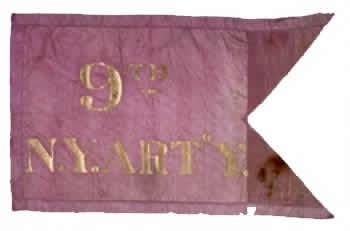
9th Regiment Artillery (Heavy), NY Volunteers | Flank Markers | Civil War
These purple, silk swallowtail flank markers include a painted regimental identification. To create the swallowtail, a horizontal cut was made from…
NYSMM Online Resources
Battles and Casualties from Phisterer (pdf)
Battles and Casualties from Phisterer (spreadsheet)

